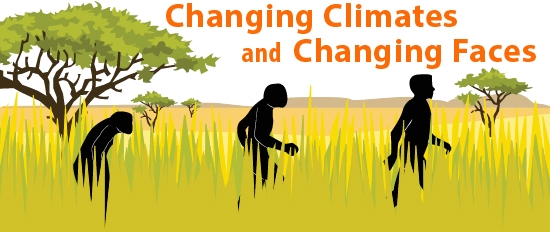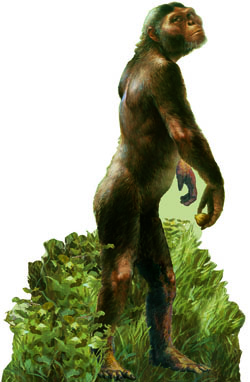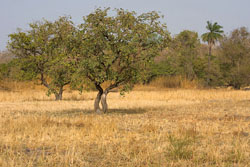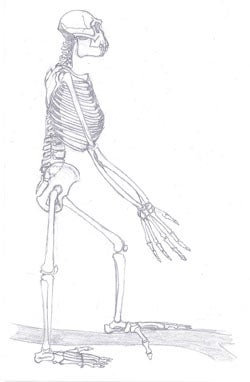
Changing Climates and Changing Faces
 Three million years ago a chimpanzee-sized creature stood up on two legs. While she may have looked like a chimpanzee, she was not—she was a member of Australopithecus, an ancient human ancestor. One way we know this is because she walked on two legs just like humans today.
Three million years ago a chimpanzee-sized creature stood up on two legs. While she may have looked like a chimpanzee, she was not—she was a member of Australopithecus, an ancient human ancestor. One way we know this is because she walked on two legs just like humans today.
She used her two legs to walk between grasslands so that she could reach the trees that had her favorite food—fruit. Some scientists think that early humans began walking on two legs so that they could move between food patches. Early humans might have been driven to walk on two legs as fruit-bearing forests shrunk and grasslands spread when climate changed over the last six million years.
However, this is just one of many ideas of how climate change may have influenced human evolution. How our ancestors responded to climate change falls under the science of ecology.
Standing up in savannas
 The "savanna hypothesis" is one of the oldest ideas on the effects climate change had on early humans. The idea is that the spread of grasslands was important to the evolution of our ancestors in Africa. We know that grasslands spread as the climate became cooler and drier over the last six million years.
The "savanna hypothesis" is one of the oldest ideas on the effects climate change had on early humans. The idea is that the spread of grasslands was important to the evolution of our ancestors in Africa. We know that grasslands spread as the climate became cooler and drier over the last six million years.
Some scientists think that our ancestors first stood up on two legs to peek over tall grasses to avoid predators. Others think they evolved to walk on two legs so that they could move across grasslands to reach tree patches on the landscape. These tree patches held the fruits early hominins relied on. Many other ideas like these have been suggested. In fact, almost all major "events" in human evolution (stone tool use, brain size increase, etc.) have at one time been linked to the spread of savanna in Africa. Walking on two legs (bipedalism) is likely the trait most closely tied to spread of the savanna. This idea is still an area of intense research today.
 Ardipithecus ramidus is a 4.4 million year old human ancestor that is known from East Africa. The fossil animals, plants, and ancient soils that are found with A. ramidus suggest that this early human lived in a habitat with a lot of trees, like a forest. This challenges the idea that walking on two legs was driven by spread of the savanna, as one of the earliest bipeds was found in a woody habitat.
Ardipithecus ramidus is a 4.4 million year old human ancestor that is known from East Africa. The fossil animals, plants, and ancient soils that are found with A. ramidus suggest that this early human lived in a habitat with a lot of trees, like a forest. This challenges the idea that walking on two legs was driven by spread of the savanna, as one of the earliest bipeds was found in a woody habitat.
However, more recently a group of geologists announced a study of ancient East African soils over the last six million years. These scientists found that savannas had been common across East Africa for millions of years. They thought that this supported the idea that savannas could have driven early humans to walk on two legs. Although this is the most recent study, the debate is not settled. Several scientists still think that the earliest bipeds lived in wooded, semiforested habitats.
Variability and flexibility
There are a few alternatives to the savanna hypothesis. One is that changes in temperature or rainfall influenced human evolution. These types of changes are called climate variability.
 Other scientists think that great expansions and contractions of lakes broke up and rejoined groups of early humans over time. Lake expansion and contraction could have caused new species to form. Speciation can occur when populations are divided and take on their own evolutionary paths. Such divisions could also have caused the evolution of new adaptations. Hominin species might have had to change their behaviors when they came into contact with one another. These new behaviors may have evolved when species had to compete for food.
Other scientists think that great expansions and contractions of lakes broke up and rejoined groups of early humans over time. Lake expansion and contraction could have caused new species to form. Speciation can occur when populations are divided and take on their own evolutionary paths. Such divisions could also have caused the evolution of new adaptations. Hominin species might have had to change their behaviors when they came into contact with one another. These new behaviors may have evolved when species had to compete for food.
Changing climates may also drive evolution for other reasons. Humans and our ancestors have to be more flexible in how they interact with an area if their habitat is changing. To be successful in a changing world, you would want to be a generalist rather than a specialist. When a specialist's preferred food, habitat, or any other resource disappears, it is hard for them to survive. Generalists are more flexible and so can more easily change with the environment. For example, stone tool use may have helped hominins exploit a new resource (meat). An ability to hunt for meat could be critical when other resources, like plants, were scarce during periods of global cooling.
Bibliographic Details
- Article: Changing Climates and Changing Faces
- Author(s): John Rowan
- Publisher: Arizona State University Institute of Human Origins Ask An Anthropologist
- Site name: ASU - Ask An Anthropologist
- Date published:
- Date modified:
- Date accessed: December 18, 2025
- Link: https://askananthropologist.asu.edu/stories/changing-climates-and-changing-faces
APA Style
John Rowan. (). Changing Climates and Changing Faces. Retrieved 2025, Dec 18, from {{ view_node }}
American Psychological Association, 6th ed., 2nd printing, 2009.
For more info, see the
APA citation guide.
Chicago Manual of Style
John Rowan. "Changing Climates and Changing Faces." ASU - Ask An Anthropologist. Published . Last modified . https://askananthropologist.asu.edu/stories/changing-climates-and-changing-faces.
Chicago Manual of Style, 17th ed., 2017.
For more info, see the
Chicago Manual citation guide.
MLA Style
John Rowan. Changing Climates and Changing Faces. ASU - Ask An Anthropologist. , {{ view_node }}. Accessed December 18, 2025.
Modern Language Association, 8th ed., 2016.
For more info, see the
MLA citation guide.

Is our climate still changing today? Learn what we know about today's weather and climate at Ask A Biologist's story Crazy Climate and Wacky Weather
Be Part of
Ask An Anthropologist
By volunteering, or simply sending us feedback on the site. Scientists, teachers, writers, illustrators, and translators are all important to the program. If you are interested in helping with the website we have a volunteers page to get the process started.
